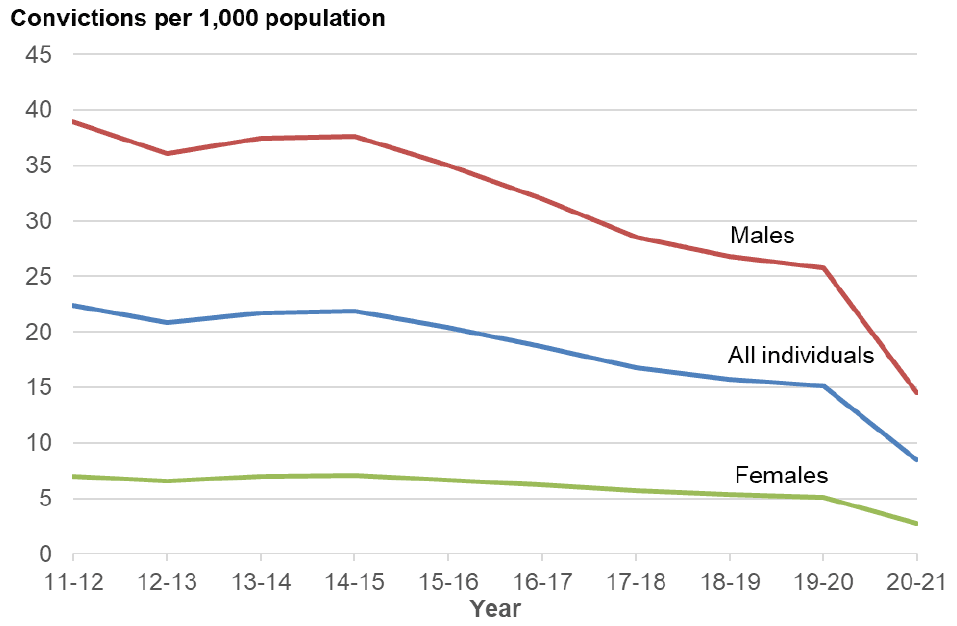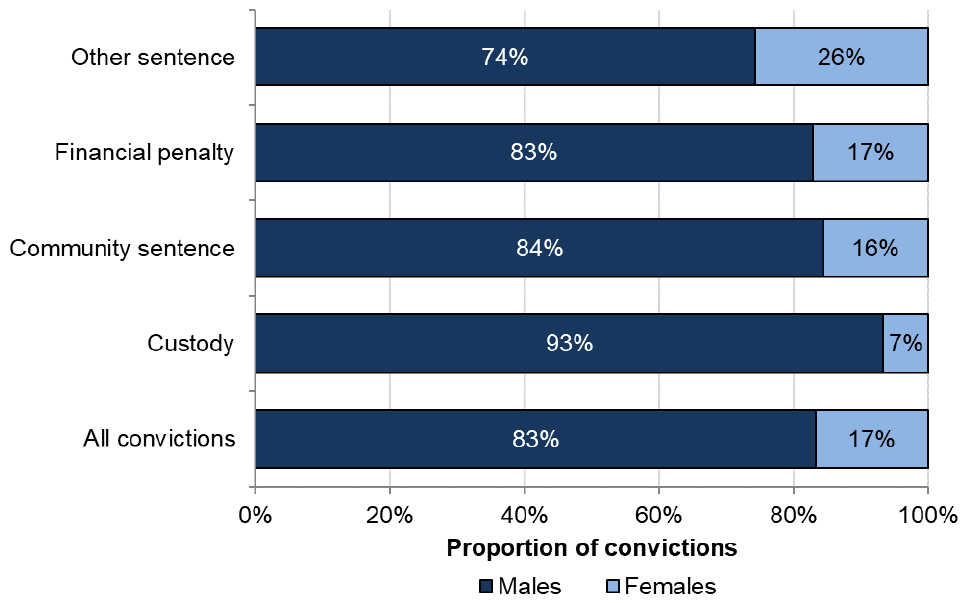Criminal proceedings in Scotland: 2020-2021
Statistics on criminal proceedings concluded in Scottish courts and alternative measures to prosecution issued by the police and the Crown Office and Procurator Fiscal Service are presented for the ten years from 2011-12 to 2020-21. The latest year’s data is impacted by the COVID-19 pandemic.
14. Age and sex
(Tables 5a-c, 6a-b, and 11)
Sex in this bulletin is generally based on a person’s physiology as perceived by a police officer, rather than self-identified gender, and is recorded when a person’s details are entered into the CHS. Sex may be different to that recorded at birth if a person has a Gender Recognition Certificate. In a small number of records sex will be recorded as unknown if a clear understanding of the sex of the individual is not known. See Annex D for further details.
In 2020-21 there were 8 convictions per 1,000 population. There were more convictions for males at 15 convictions per 1,000 population compared to three for females.
The overall number of convictions per 1,000 population has declined over the last ten years from 22 convictions per 1,000 population in 2011-12. The decline has been driven by a decrease for males, down from 39 convictions per 1,000 population in 2011-12 to 15 in 2020-21. The number for females has been consistently much lower than for males, but also shows an overall decline, from seven to three convictions per 1,000 population between 2011-12 and 2020-21 (Chart 14). Note that the sharp decline in the past year is a reflection of the substantial drop in the total number of convictions overall due to the impact of COVID-19 on court activity.

Over the past 10 years, the gap between the number of convictions per 1,000 population for younger people compared to older people has become smaller. This has been driven by a fall in the number of convictions per 1,000 population for younger people, especially younger men. For people aged 31 to 40 and 41 to 50, the number has been on a more gradual downward trend over the last decade.
In 2011-12, the age group with the highest numbers of convictions per 1,000 population was those aged 21 to 30, with 55 convictions per 1,000 population. Since then, this has changed. In 2020-21, the highest number of convictions per 1,000 population was for the 31 to 40 age group overall (18 per 1,000), the 21 to 30 age group also showing a similar 17 convictions per 1,000 population.
Convictions by sex, age and crime type
Males accounted for 83% of all convictions in 2020-21, a similar proportion as each year in the past ten years. More males than females were convicted in all crime/offence categories.
Whilst females accounted for 17% of all convictions, they accounted for relatively higher proportions of convictions for the following crime types in 2020-21:
- 44% (49 convictions) of other non-sexual crimes of violence. The vast majority of these were for “cruelty to and unnatural treatment of children” convictions;
- 34% (905 convictions) of all shoplifting convictions;
- 32% (69 convictions) of all fraud convictions; and
- 38% (3 convictions) of all drunkenness and other disorderly conduct convictions.
Compared to older people, a larger proportion of convictions for people under 21 are for crimes against public justice and common assault. For example, a fifth of convictions (20%) for females under 21 were for common assault with the corresponding figure for males being 13%. By contrast common assault accounted for smaller proportions of convictions for both men and women aged over 40 (10% and 12% for males and females respectively).
Convictions for motor vehicle offences accounted for higher proportions of convictions for those aged over 40; 28% of males, and 34% of females convicted. This compares to the under 21 age group where 20% of males and 18% of females were convicted of motor vehicle offences.
Sentencing by sex and age
Overall, males are more likely to receive a custodial sentence than females. This is illustrated by males accounting for 83% of all people convicted in 2020-21 but representing a higher proportion of all custodial sentences (93%). Females were more likely to be issued with an “Other sentence” (which are mostly admonishments) with 26% of these types of punishments having been given to females compared to the 17% of all convictions that females represent (Chart ).

Please note that sentencing decisions are reflective of a number of factors such as the severity of the crime and whether the individual has offended in the past. In addition, the decision on what type of punishment is reasonable will be based on the personal circumstances of the offender. These statistics do not take account of these factors. The Reconviction Rates in Scotland National Statistics present analyses on the last sentence received in a financial year, by the number and type of previous crimes and sentences.
Contact
Email: justice_analysts@gov.scot
There is a problem
Thanks for your feedback